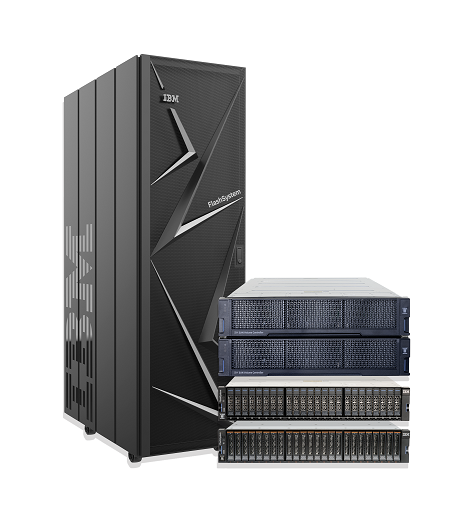IBM Simplifies Storage Lineup: New FlashSystem Family Replaces Storwize, A9000 Lines
IBM is jumping ahead of rivals like Dell Technologies and HPE by replacing multiple incompatible storage families with a single new family, which is scalable from entry-level to enterprise.

IBM on Wednesday said it is eliminating two of its primary non-mainframe storage lines--Storwize and the Flash Systems A9000--and replacing them with a single new FlashSystem family.
The move will take two incompatible storage lines out of the IBM product lineup and replace them with a line that provides compatible storage software and services from entry level to the highest enterprise, said Eric Herzog, chief marketing officer and vice president of worldwide storage channels for IBM storage.
"All our existing product lines, not including our mainframe storage, will be replaced by the new FlashSystem family," Herzog told CRN. "They have more functions, more features, and lower prices."
[IDC: NetApp Tanks, Huawei Banks As Storage Industry Realigns]
No changes are planned for the DS8000 storage systems, which are focused on the mainframe market, Herzog said.
Nearly all the top storage vendors have multiple incompatible storage lines targeting the non-mainframe market. For instance, Dell Technologies has its Unity, SC, PowerVault, XtremIO, and VMAX lines in addition separate lines for unstructured storage, while Hewlett Packard Enterprise offers the Nimble, 3PAR, and new HPE Primera lines.
IBM solution providers praised the move to simplify the IBM storage story.
The consolidation of IBM's non-mainframe storage into the FlashSystem family is a really solid move on IBM's part, said Bob Elliott, vice president of storage sales at Mainline Information Systems, a Tallahassee, Fla.-based solution provider and long-time IBM channel partner.
"IBM is taking the benefits of its Storwize and all-flash storage families, all the power of Storwize and all IBM's storage virtualization technology," Elliott told CRN. "By marrying the two together, customers will get super high performance, super scalability, a common interface, and most important, the simplification. To me, it just makes perfect sense."
While Mainline sells storage from various manufacturers, IBM has gone the extra step in creating a single upgradable product line from entry-level to enterprise, Elliott said.
"IBM has put customers in a position where they have to look at IBM or it will be a mistake," he said. "Customers will look at IBM more than in the past. IBM customers have always been smart, and understand IBM's virtualization message. And many of them have bought into the IBM flash performance message. But putting them together will now get the attention of non-IBM customers."
Phil Godwin, president and chief operating officer at Clear Technologies, a Dallas-based solution provider and long-time IBM channel partner, said he loves what IBM is doing from a simplification standpoint.
Godwin told CRN that he has always believed that IBM has some of the best storage technology on the market.
"This will help us drive a storage story with simplification, software, and security," he said. "IBM is bringing true change to the market."
While all vendors talk about the importance of simplifying their storage lines, the fact that IBM is actually doing it is a testimony to IBM's leadership, Godwin said.
"IBM had been already working to simplify its storage software," he said. "This move will not impact IBM's storage sales. It will create new opportunities."
IBM Wednesday introduced five new storage arrays in the FlashSystem family, all running the same IBM Spectrum Virtualize software platform.
That software helps simplify customers' entire storage environment by supporting over 500 multi-vendor storage systems, and offering enterprise-class data services and non-disruptive data movement all controlled by a single management plane, Herzog said.
The new FlashSystem family also offers 99.9999-percent availability, full hardware redundancies, and two-site or three-site replication. The also provide seamless hybrid multi-cloud support, and offer a full range of security capabilities, he said.
All those capabilities are available from entry-level to enterprise-class FlashSystem products, with the exceptions of a few capabilities which will not run on the entry-level models because their controllers do not have enough power to do so, he said.
Three of the five offer NVMe flash and Fibre Channel NVMe host connectivity, high-performance compression and compression with IBM's FlashCore Modules, external storage virtualization of non-IBM storage, and expandability with storage class memory, Herzog said.
The new FlashSystem entry-level and midrange arrays will be sold exclusively via channel partners, while the high-end arrays will be available via partner-led sales, partner co-selling with IBM, or IBM direct, he said.
"We're not changing our go-to-market at all," he said. "Globally, about 70 percent of our storage goes through indirect channels, including software and systems."
The company's Storwize and A9000 line will be available for purchase through November of this year, with final deliveries slated for December. Customers will be able to upgrade their existing Storwize and A9000 systems' capacity and memory through the end of 2021, and those systems will be supported through December of 2024.
However, Herzog said IBM expects customers to move quickly to adopt the new FlashSystem arrays. For instance, he said, the new FlashSystem 9200 offers three to four times the performance and 17 times the rack density of the current A9000, but at a price that is 40 percent to 60 percent cheaper, depending on configuration.
IBM is also making its existing Storwize and A9000 systems eligible for the company's tech refresh campaign which offers incentives to convert to new IBM storage technology, he said.
The new IBM FlashSystem arrays are slated to be in general availability in early March.